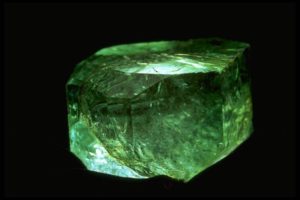
The Gachala Emerald was discovered in 1967 in the mine called Vega de San Juan, located in Gachala, a town in Colombia, 142 km (88 mi) from Bogota. It is one of the most precious and popular emeralds in the world. Gachalá Chibcha means “Gacha’s spot.” Today, the emerald is in the United States, where the New York City jeweler, Harry Winston, donated it to the Smithsonian Institution.
The more pure green color the emerald displays, the more valuable it is. Its color is caused by impurity atoms of either chromium or vanadium, which are incorporated into beryl crystals as they grow.
The emerald was named in honor of Gachalá, the municipality of Cundinamarca where it was found
Characteristics of Gachalá Emerald
Shape: Emerald
Color: Intense green
Carats: 858 Carats
Weight: 172 grams
Size: 5 centimeters
Year of extraction: 1967
The “Gachala Emerald” is a thin hexagonal prism with a height of 5 cm and a diameter of almost the same length, which conforms to the normal crystal habit of the emeralds. At the upper end of the crystal, the hexagonal form of the crystal is more apparent, but it is not a regular hexagon with two opposite sides of the hexagon shorter than the other four sides. Even on the sides of the crystal, the six sides of the crystal can be marked, although from the sides the crystal appears more cubical than hexagonal. The crystal color is a pure dark green, and it appears that the crystal is opaque. We may not be able to say anything about the gemstone’s diaphaneity unless the crystal is polished. Nevertheless, it is well known that with enhanced brightness, most Gachala emeralds have strong clarity and shine. One of the world’s largest gem-quality emerald crystals, the “Gachala Emerald.”
Where was the Gachala emerald found?
In 1967, the 858ct Gachala Emerald crystal was discovered in Gachala, Colombia, at the Vega de San Juan mine. These scale and superb color emerald crystals are rarely preserved; they are usually cut into gems. Harry Winston gave the Smithsonian the Gachala Emerald in 1969.
Gachala Emeralds Special Features
Generally speaking, gachala emeralds are finer, with less defects and inclusions than emeralds from other Colombian mines like Muzo, Coscuez and Chivor. For strong visibility, transparency and brightness, the emeralds are usually “brow clean.” Their color is typically pale green, though. The darker vivid green colors, despite the presence of inclusions, command the highest prices compared to the pale green but much cleaner stones, is a crucial factor in emerald color that defines their value. Sadly, the best green colors tend to be the most included in the emeralds.
The Gachala Emerald exhibited at the Tucson Show of February 2003
At the 49th Tucson Gem & Mineral Society exhibition in February 2003, the “Gachala Emerald” was displayed. Michael Scott, former president of Apple Computer Company, who is also a collector and connoisseur of gemstones and minerals, opened the show from 13 to 17 February with an evening reception and chat. The theme of the 2003 exhibition was the “Minerals of the Andes.” The display was attended by several private collectors and museums, which displayed a great collection of specimens of Andes origin as well as from other sources.
The exhibition was a spectacular success, with one of the best ever being said to be the variety of exhibits shown. The exhibition was attended by about two dozen museums and pulled out their best exhibits. The Star attraction among the displays shown by the Smithsonian Institution’s National Museum of Natural History was the 858-carat “Gachala Emerald,” of Andean origin, which was exhibited in tandem with the famous Marjorie Merriweather Post emerald necklace, also of Colombian origin, with 24 baroque polished round emeralds. Two proustites, a Bolivian phosphophyllite crystal accompanied by a faceted diamond of 26.9 carats, and other unusual specimens such as franckeite, andorite, helvite, and canfieldite were among the other mineral specimens of Andean origin displayed by the Smithsonian Institution.
Michael Scott, Gene and Roz Meieran, Bill Larson, Rock Currier, Steve and Clara Smale and W were among the private collectors who showed impressive exhibits that gained much attention. There’s R. Danner.
The Gachala Emerald is exhibited at the Smithsonian’s NMNH
As part of the National Gem Collection, the “Gachala Emerald” is now on display at the Janet, Annenberg Hooker Hall of Geology, Gems and Minerals, the Smithsonian National Museum of Natural History, along with other famous emeralds such as the Mackay Emerald Necklace, the Hooker Emerald Brooch, the Chalk Emerald Ring, the Maximilian Emerald Ring, the Spanish Inquisition Necklace and others.










